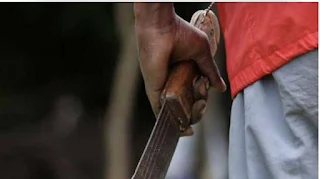Mungiki emerged in the late 1980s in what was then Kenya's Rift Valley Province. The province was the site of simmering conflicts over land ownership and rights between the indigenous majority (mainly the Kalenjin) and more recently arrived settlers (mostly Kikuyu).
The early 1990s witnessed the first bout of politically instigated inter-ethnic conflict intended to diminish Kikuvu influence in local politics. Mungiki emerged as a Kikuyu youth movement, defending the dispossessed: women, migrants and landless youth.
At this time the grouping also opposed the autocratic and corrupt government of Daniel arap Moi, a Kalenjin. Later, Mungiki groups were co-opted by Moi and used in election politics. He was the first of a series of high-ranking politicians to do so.
The politics of ethnicity laid the groundwork for Mungiki.
In
the 1997, 2002 and 2007 parliamentary and presidential elections, leading politicians mobilised violent youth militia in support of their campaigns.
After the disastrous 2007 presidential elections, Mwai Kibaki's victorious Kikuyu-dominated Party of National Unity mobilised Kikuyu youth militia in retaliation against the gangs deployed by the opposition party, Orange Democratic Movement. Mungiki was central in the resulting violence.
By the turn of the millennium, Mungiki had become a mostly urban phenomenon.
Poverty, youth unemployment and political disillusionment created fertile ground for the group. Young men in particular regarded themselves as a "no future" generation, seeing that they had few opportunities to establish themselvesas successful adults with the economic means to sustain a family.
Urban informal settlements were neglected by the state and local authorities. Youth-based groups filled the void. In Nairobi's shantytowns, Mungiki activists and militia competed with other militias like Kamjesh, and the Taliban in Mathare Valley. Like Mungiki they were involved in the war over public transport, provision of basic services like electricity and demanding protection money from businesses. But they also had a role in welfare, job creation and security.
What are the group's practices and beliefs?
Mungiki is based on the intersection between generation, ethnicity, religion and class. Its members are young, poor and predominantly Kikuyu, the largest ethnic group in Kenya. Mungiki operates primarily in urban neighbourhoods where it combines vigilante, welfare, cultural and criminal activities. It uses violence to achieve and maintain control. Over time it has had close but unstable links with political parties and leaders, and has sought, won and lost registration as a political party, National Youth Alliance.
Mungiki can be understood as a neo-traditional social movement. It reaches back into Kenya's pre-colonial and colonial history for the origins of its beliefs and practices. It bases its values on Kikuyu religion and cosmology.
AA
nation.africa


Post a Comment